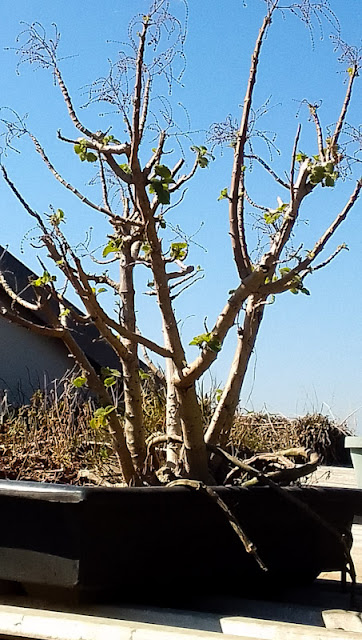Common names:
English: misty plume bush, ginger bush
Zulu: iboza, ibozane
The inflorescence of the iboza plant
This plant was previously classified under the genus Iboza,
which was derived from its Zulu name which refers to the aromatic qualities of
the plant. Tetradenia means 'four glands' and riparia translates to 'growing on
banks of rivers'.
Tetradenia riparia belongs in the mint and sage family Tetradenia riparia belongs in the mint and sage family Lamiaceae (which includes familiar culinary herbs such as thyme, sage and rosemary).
Tetradenia riparia is mostly found growing in warmer areas, on wooded hillsides, forest margins, dry wooded valleys usually growing amongst rocks.
Inflorescences
The inflorescences are branched, large bunches at the ends
of the shoots. The individual flowers are about three millimeters in diameter
and would appear in veins, the flowers range in color from white to lilac, and
pink flowers are also found. Male flower spikes have more of the
"mist" effect than the female flowers which tend to be more compact.
Flowering occurs in wintertime, in South Africa from June–August when the plant
is bare.
The flower of the male iboza plant
The type of display which you will get depends on whether you have a male or female plant. Male and female flowers are borne on separate plants in spikes which differ in size and shape. The male flower spikes in profusion create more of the "mist" effect than the female flowers which tend to be more compact.
The female flower of Tetradenia riparia
The leaves are ovate-oblong to almost round or heart-shaped 30-180
x 30-140 mm, with irregularly, somewhat bluntly toothed margins.
They are a bright green colour and are slightly sticky to
the touch due to the presence of whitish, velvety, glandular hairs on both
surfaces.
Venation is indented above, prominent below, and they exude
a strong, aromatic scent when handled.
Like many Lamiaceae species , the younger branches are distinctly
four-angled in cross section
Medicinal uses
Tetradenia riparia is a medicinal plant known to the Zulu
people as iBoza for which they have many uses for including the relief of chest
complaints, stomachache and malaria. Inhaling the scent of the crushed leaves
apparently also relieves headaches.
An essential
oil extracted from its leaves has antimalarial properties.
Laboratory
studies have shown that the herb contains ingredients that moderate the
malaria-causing Plasmodium falciparum parasite. An extract from the leaves has also
been found to inhibit bacterial growth.
I
have found that a mixture of iboza and Artemisia afra wild wormwood leaves in
boiling water when inhaled works well to relieve the symptoms of colds and flu.
Ecology
The pollen and nectar rich
flowers attract many species of insects, in particular the Africa honeybee, Apis
mellifera scutellata. This is an important forage plant for these bees in the Winter
months.
Tetradenia riparia is associated
with a moth (Trichoplusia molybdina) of the predominately night-flying Noctuid
family.
Growing Tetradenia riparia
Tetradenia riparia is a
rewarding easy to grow garden plant which is fast growing and will flower in
its first year.
Plant iboza in full sun, except
in very hot areas where midday shade or light shade may be beneficial.
Although Tetradenia riparia is
usually found in the wild growing in poor soil in rocky localities requiring
little water, in cultivation it will grow very rapidly if planted in well
drained and well composted soil, at times too rapidly. To grow at its optimum,
it needs to be well watered in the summer growing period but needs to be
allowed to dry out and lose its leaves in winter for good flowering. rainfall
areas, especially the bushveld regions. Because of this high degree of adaptability,
it is also well suited to water wise gardens,
Tetradenia riparia must be pruned back hard after flowering to keep it neat and promote flowering.
Although iBoza is very drought resistant,
in grows best if well-watered in the summer growing period, being allowed to
dry out completely in autumn for best flowering which occurs in winter if it is
leafless.
Roof Gardens
Tetradenia has proved to be a
very drought resistant xerophyte when grown in poor shallow soils as a green
roof plant.
Tetradenia riparia plants trialed as part of the Ethekwini
Municipality Green Roof Pilot Project in early 2009 are still thriving in
August 2024, over 15 years later.
Plants trialed as part of the Ethekwini
Municipality Green Roof Pilot Project in early 2009 are still thriving in
August 2024.
In addition, plants of iBoza
have established themselves naturally in
trials that I have conducted at my home. In both cases these plants have only received
rainwater, never having been watered since their establishment.
This Tetradenia riparia established its self in a growing tray on my roof
Growing indoors.
After wind blown seed germinated
in the pots of orchids that I am growing indoors I discovered that they grow
very well indoors remaining evergreen making them very desirable indigenous greenery
for indoors, however so far they have not flowered indoors.
Propagation
Tetradenia riparia is very easily
propagated from cuttings, even from quite large truncheons which can simply be
planted into the ground where one wants to grow them. They need do drying off
or root hormones, just stick them into the ground and water occasionally until
they have rooted and produced the first good growth thereafter, they can be
watered normally. Just do not overwater them or they may rot. They can also be
rooted in river sand, but this is probably unnecessary. To propagate Tetradenia
in large numbers it is easiest to grow them from seed, but this requires an
amount of propagation know how.
https://pza.sanbi.org/tetradenia-riparia
https://en.wikipedia.org/wiki/Tetradenia_riparia
https://cjmgrowers.co.za/tetradenia-riparia/
Article written by Michael Hickman on the
16.08.24
Please visit my websites at
https://www.hlem.co.za/indigenous_plants/plants.html
other blogs at
https://ecomandurban.blogspot.com/
https://luthulienvironment.blogspot.com/
https://emalangeniforest.blogspot.com/










No comments:
Post a Comment